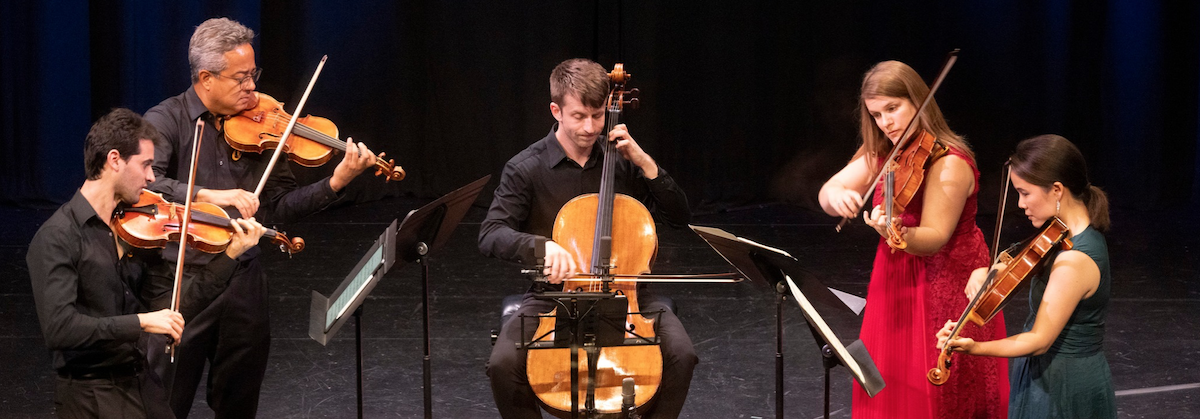If there is such a thing as perfection in the arts, or anything else for that matter, the superb string-player squadron on hand for the opening chamber concert of this summer’s Festival Mozaic nailed it, if not vaulted right on over it . . . with a dash of added excellence from pianist John Novacek where required.
I’ll do my best to back up my claim.
A near capacity audience and I were seated in the Harold J. Miossi Center for the Performing Arts at Cuesta College last Friday, July 18. We were treated to four different major string ensemble works—one requiring the aforementioned piano—with each having its own group of string players, totaling 19 in all.
Each piece had a facet of uniqueness that added to the impact of its performance.
The performers gave a well-honed example of the genre including great balance and blend and crisp stylish agreement . . .”
The opening work, “Divertimento a Cinque (Cassation) in G major” Hob. II:2, is an early work by the well-known Classical era composer Joseph Haydn. The title partially translates to “Entertainment for Five,” in this case five string players: Cameron Alan-Lee and Jason Uyeyama, violin; Jessica Chang and Jessica Oudin, viola; and Ari Evan, cello.
Its six short movements befit a piece whose purpose is to provide outdoor listening or dancing entertainment. In this case, five of the movements are dances or dance-like, while the fourth is a slow, more song-like movement. The performers gave a well-honed example of the genre including great balance and blend and crisp stylish agreement such as matching embellishments, dynamic shaping, and articulation.
It was apparent that Novacek—an afficionado of this style—was in a ‘happy place.’”
The second work, “Piano Quintet in A minor” was unique in that American composer Florence B. Price, a Black woman, wrote it in the early decades of the 20th century. With Jim Crow laws still in effect, she had to fight hard to gain recognition and get performed. The performers included Eunice Kim and Jisun Yang, violin; Hannah Nicholas, viola; Sophie Shao, cello; and John Novacek, piano.
There were many hints of the musical styles that had impressed Price’s compositional language—from the lushness of the French post-Romantic harmonies in the first and last movements, to spirituals in movement two along with Juba, the uplifting African-American dance with a very familiar early-jazz feel. It was apparent that Novacek—an afficionado of this style—was in a “happy place.” I was somewhat disappointed that—beautiful as this piece is, overall—the emphasis mostly rested with the pianist and first violinist. The performance earned a standing ovation.
The opposite was to be found in Erwin Schulhoff’s “Fünf Stücke für Streichquartett” (Five Pieces for String quartet). Written in 1923, these short works were written as spoofs on five popular dances of the preceding century, incorporating many of the new “modernist” techniques of that time. The intrepid group giving a masterful rendering of this intriguing piece were Steven Copes and Rannveig Marta Sarc, violin; Jenni Le, viola: and Ani Aznavoorian, cello.
The movements included:
- Valse: Mocking the Viennese “OOM-pah-pah” waltzes made famous by “Waltz King” Johann Strauss II by using three-beat accents in a two-beat meter.
- Serenade: A darkly guised spoof on the Renaissance troubadour’s song form. Col legno (striking the strings with the wood of the bow) from the viola and cello was very effective at the end.
- Czecha: A wild and crazy rendition of a folk-dance from his homeland.
- Tango: Slinky and not quite sinister.
- Tarantella: Wilder and crazier? You betcha!
Capping the evening’s event was an absolute blow-out performance of Ernő Dohnányi’s “String Sextet in B-flat major,” Wo80. The artists involved were Scott Yoo and Young Artist Program member Anne-Marie Wnek, violin; Caitlin Lynch and Young Artist Program member Daniel Simmons, viola; and Robert deMaine and Young Artist Program member Ethan Blake, cello.
The entire octet was beautifully in sync.”
The music was certainly evocative of the late Romantic era (think Brahms, Rachmaninoff)—but less adventurous than Skriabin. Remember, however, that this was written for entry into a conservatory, so using more “modern” techniques—had he known them—might not have been the wisest approach.
I think Scott Yoo and his colleagues achieved the level of quality Yoo prophesized in his “Notable Encounter” last Thursday when he proclaimed, “We’re going to be [performing this] perfect[ly]!”
The entire octet was beautifully in sync: note-wise, rhythmically, dynamics, articulation, and most of all emotionally expressive.
What an achievement! No wonder they received the second standing ovation of the concert.
